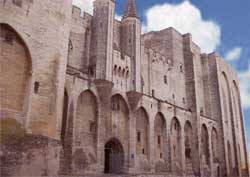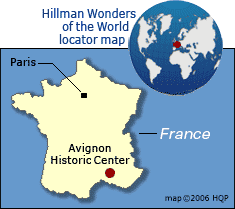Avignon Historic Center
 Why the
Avignon Historic Center
is special
Why the
Avignon Historic Center
is specialIt is home to several major historical structures (including the Papal Palace) and a major international cultural festival.
Papal Palace tips and insights
Also known as
The Papal Palace is also called the Palace of the Popes. The first is now the official English name.
Creation
It was constructed in the 14th century after Pope Clement V moved the papal seat from Rome to Avignon. Eventually, the papal command center returned to Rome.
Building style
Though this Gothic edifice is called a palace, it has the look and feel of a fortified citadel (see photo). The papacy had its enemies.
Misfortunes
Nearly all the furnishings were plundered or destroyed long ago. Except for frescoes and some items, there isn't much left inside to excite the eye. However, the exterior certainly does.
Square
The Papal Palace faces a large square that is shared by other interesting buildings.
The Notre Dame des Doms cathedral is the top must-see.
More Avignon Historic Center tips & insights
Famous nearby bridge
Nearby is the famed medieval Avignon Bridge. It juts over the river, then abruptly ends midstream. Reason: Only 4 of its original 22 arches remain. This bridge is also well-known because it's the subject of the classic French children's song, "Sur le Pont d'Avignon".
Avignon old city
It is still surrounded by substantial fortified medieval walls.
Major cultural festival
An internationally renowned theatre, music and dance festival takes place in Avignon in July. Most of the highlights are staged inside the Papal Palace, though there is significant performance activity in other locations, including on the streets.
Location in France



